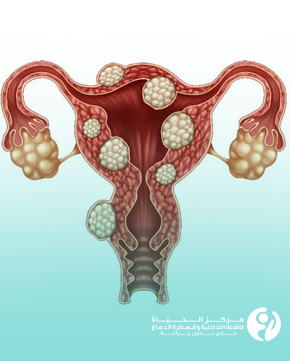
Uterine fibroids are a common condition that affects women of reproductive age. These tumors can cause many problems, including difficulty in conceiving a child. In this article, we will explore how fibroids can be treated non-invasively using interventional radiology.
Uterine fibroids, symptoms and causes:
Uterine fibroids, also known as leiomyomas, are growths of benign, non-cancerous cells that develop in the uterine wall and are particularly common in women in their reproductive years. Symptoms vary from one woman to another and depend on the size, location, and number of tumors.
The common symptoms of uterine fibroids:
- A heavier menstrual flow for longer than usual.
- Enlarged uterus.
- Pain or pressure in the pelvic region.
- Frequent urination due to the pressure of the enlarged uterus on the bladder.
- Difficulty emptying the bladder.
- Constipation and a feeling of bloating.
- Feeling of back or leg pain.
- Painful intercourse.
- Conceiving difficulties.
Possible causes of uterine fibroids:
Hormones: Estrogen and progesterone, the hormones that stimulate the growth of the endometrium, can promote the growth of fibroids.
Genetic factors: Some fibroids may be caused by specific genetic changes.
Growth factors: Certain proteins that help maintain tissues may affect the growth of fibroids.
The types of the uterine fibroid:
The appearance of a uterine fibroid varies depending on its location:
Submucosal fibroids: Fibroids grow in the inner cavity of the uterus.
Intramural fibroids: Fibroids grow inside the muscular wall of the uterus.
Subserosal fibroids: Fibroids grow outside the uterine wall.
Treatment of fibroids:
There are several ways to treat fibroids, including surgical and non-surgical treatments. The choice of treatment for fibroids depends on their size, symptoms, and the patient's wishes. Fibroid treatment options include:
- Medications: Certain medications are used to relieve symptoms and control the growth of tumors.
- Interventional radiology: Interventional radiology techniques can destroy tumors without surgery.
- Hysterectomy: This treatment is used in rare cases such as several large tumors or failure of other treatments.
Interventional radiology in the treatment of fibroids without surgery:
Among non-surgical treatments, interventional radiology stands out as one of the most effective options.
Interventional radiology is a non-invasive medical technique that uses radiation guidance to deliver precise treatments for fibroids. Common procedures within interventional radiology to treat fibroids include:
Treatment with Arterial Embolization: A thin catheter is inserted through the blood vessels and guided to the arteries feeding the fibroid, where substances are injected that block the blood flow to the tumor, causing it to shrink.
Focused Ultrasound Therapy: Uses ultrasound to heat and destroy targeted fibrous tissue without incisions.
Advantages of treating fibroids with interventional radiology:
1- A non-invasive procedure, which means no incision is required, thus minimizing potential surgical complications and shortening the recovery period after treatment.
2- High accuracy, where medical imaging equipment is used to guide the catheter precisely to the artery feeding the tumor without affecting the surrounding arteries. Interventional radiology also targets fibroids without the surrounding healthy tissue, preserving the normal function of the uterus.
3- No need for general anesthesia, as interventional radiology treatment of fibroids is usually performed using local anesthesia, reducing the risks associated with general anesthesia.
4- Highly effective, studies have shown the effectiveness of interventional radiology in treating uterine fibroids, either by reducing their size or removing them completely.
5- Safe, interventional radiology treatment causes fewer side effects compared to surgery, such as some redness or temporary localized pain that fades after a short period.
6- Preserving the uterus, interventional radiology treatment restores the ability to conceive and safely complete a pregnancy, without having to perform a hysterectomy to treat fibroids.
The best doctor in treating fibroids without surgery:
When searching for the top specialist for non-surgical fibroid treatments, it is important to look at experience and reputation in the field of fibroid treatment and the ability to skillfully use interventional radiology techniques.
Al Hayat Center has a team of doctors with extensive experience in treating uterine fibroids using modern techniques to provide the best care for patients.
Al Hayat Center for non-surgical fibroid treatment :
Al Hayat Center is one of the leading centers offering the latest technology for the treatment of fibroids. The Center provides an advanced medical environment and relies on a team of experts in interventional radiology to ensure the best possible care for patients.
If you are experiencing symptoms of fibroids, head to Al Hayat Center for Interventional Radiology and Neurointervention to speak with the healthcare team and inquire about all the steps required to start interventional radiology treatment.
My experience in eradicating fibroid tumors:
‘After years of suffering from the symptoms of a large uterine fibroid tumor, I decided to look for alternatives to surgical treatment. I heard about the interventional radiology through Al Hayat Center for non-surgical fibroid treatment. My fibroid treatment experience was amazing; the medical team was professional and supportive. After the arterial catheter treatment, my symptoms gradually started to improve. Now, I feel much better and no longer suffer from heavy bleeding or pelvic pain. It was a successful experience in all aspects.’
In conclusion:
Non-surgical treatment of fibroids using interventional radiology is an advanced and effective option for women suffering from this condition. This technique offers a less invasive alternative to traditional surgery, with a shorter recovery period and fewer complications. Al Hayat Center for Interventional Radiology and Neurointervention ensures optimal care and beneficial results such as uterine preservation, no need for surgery, and high precision.

